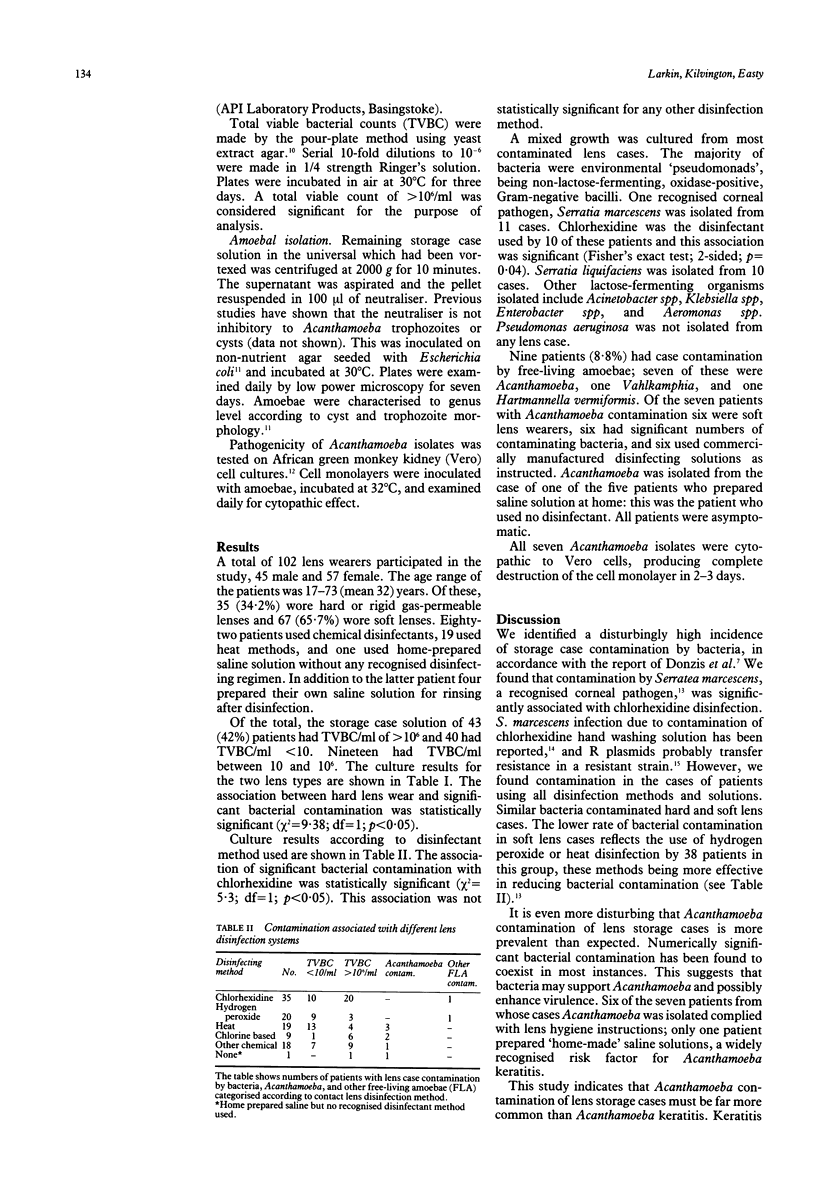Abstract
In order to identify possible risk factors for microbial keratitis the storage cases for contact lenses of 102 asymptomatic lens wearers were tested for contamination by bacteria and free-living amoebae. Of this group 43 had significant counts of viable bacteria and only 40 had negligible counts. Seven had contamination by acanthamoebae, of whom six also had significant bacterial counts. These results were categorised according to the type of contact lens worn and the lens disinfection method. The high rates of contamination by apathogenic and pathogenic organisms, in particular Acanthamoeba, and the probable support by contaminating bacteria of Acanthamoeba, are discussed.
Full text
PDF


Selected References
These references are in PubMed. This may not be the complete list of references from this article.
- Cooper R. L., Constable I. J. Infective keratitis in soft contact lens wearers. Br J Ophthalmol. 1977 Apr;61(4):250–254. doi: 10.1136/bjo.61.4.250. [DOI] [PMC free article] [PubMed] [Google Scholar]
- Cursons R. T., Brown T. J. Use of cell cultures as an indicator of pathogenicity of free-living amoebae. J Clin Pathol. 1978 Jan;31(1):1–11. doi: 10.1136/jcp.31.1.1. [DOI] [PMC free article] [PubMed] [Google Scholar]
- Donzis P. B., Mondino B. J., Weissman B. A., Bruckner D. A. Microbial contamination of contact lens care systems. Am J Ophthalmol. 1987 Oct 15;104(4):325–333. doi: 10.1016/0002-9394(87)90219-4. [DOI] [PubMed] [Google Scholar]
- Duran J. A., Refojo M. F., Gipson I. K., Kenyon K. R. Pseudomonas attachment to new hydrogel contact lenses. Arch Ophthalmol. 1987 Jan;105(1):106–109. doi: 10.1001/archopht.1987.01060010112041. [DOI] [PubMed] [Google Scholar]
- Lass J. H., Haaf J., Foster C. S., Belcher C. Visual outcome in eight cases of Serratia marcescens keratitis. Am J Ophthalmol. 1981 Sep;92(3):384–390. doi: 10.1016/0002-9394(81)90529-8. [DOI] [PubMed] [Google Scholar]
- Ludwig I. H., Meisler D. M., Rutherford I., Bican F. E., Langston R. H., Visvesvara G. S. Susceptibility of Acanthamoeba to soft contact lens disinfection systems. Invest Ophthalmol Vis Sci. 1986 Apr;27(4):626–628. [PubMed] [Google Scholar]
- Marrie T. J., Costerton J. W. Prolonged survival of Serratia marcescens in chlorhexidine. Appl Environ Microbiol. 1981 Dec;42(6):1093–1102. doi: 10.1128/aem.42.6.1093-1102.1981. [DOI] [PMC free article] [PubMed] [Google Scholar]
- Mayo M. S., Schlitzer R. L., Ward M. A., Wilson L. A., Ahearn D. G. Association of Pseudomonas and Serratia corneal ulcers with use of contaminated solutions. J Clin Microbiol. 1987 Aug;25(8):1398–1400. doi: 10.1128/jcm.25.8.1398-1400.1987. [DOI] [PMC free article] [PubMed] [Google Scholar]
- Moore M. B., McCulley J. P., Newton C., Cobo L. M., Foulks G. N., O'Day D. M., Johns K. J., Driebe W. T., Wilson L. A., Epstein R. J. Acanthamoeba keratitis. A growing problem in soft and hard contact lens wearers. Ophthalmology. 1987 Dec;94(12):1654–1661. [PubMed] [Google Scholar]
- Norton D. A., Davies D. J., Richardson N. E., Meakin B. J., Keall A. The antimicrobial efficiencies of contact lens solutions. J Pharm Pharmacol. 1974 Nov;26(11):841–846. doi: 10.1111/j.2042-7158.1974.tb09190.x. [DOI] [PubMed] [Google Scholar]
- Okuda T., Endo N., Osada Y., Zen-Yoji H. Outbreak of nosocomial urinary tract infections caused by Serratia marcescens. J Clin Microbiol. 1984 Oct;20(4):691–695. doi: 10.1128/jcm.20.4.691-695.1984. [DOI] [PMC free article] [PubMed] [Google Scholar]
- Slusher M. M., Myrvik Q. N., Lewis J. C., Gristina A. G. Extended-wear lenses, biofilm, and bacterial adhesion. Arch Ophthalmol. 1987 Jan;105(1):110–115. doi: 10.1001/archopht.1987.01060010116042. [DOI] [PubMed] [Google Scholar]


